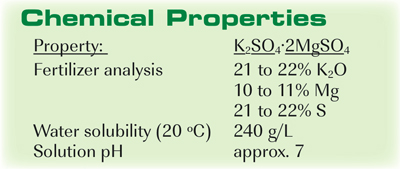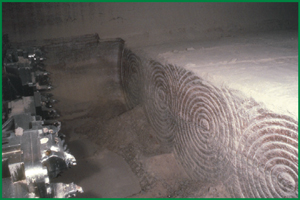Langbeinite is a unique source of plant nutrition, since three essential nutrients combine naturally into one mineral. It provides a readily available supply of Potassium (K), Magnesium (Mg) and Sulfur (S) to growing plants.
Production
A distinctive geological material, langbeinite exists in only a few locations in the world. Commercial supplies of langbeinite come from underground mines near Carlsbad, N.M., which were first commercially developed in the 1930s. These deposits formed millions of years ago, when a variety of salts, including langbeinite, were left behind after the evaporation of ancient ocean beds. These salt deposits were buried deep beneath hundreds of meters of sediment. The langbeinite deposit is currently mined with large boring machines, washed to remove impurities and then crushed to various particle sizes. Langbeinite is considered a potash (or K-containing) fertilizer, even though it also contains valuable Mg and S. Traces of iron oxide impurities give some langbeinite particles a reddish tint.

Agricultural use
Nutrient-dense langbeinite is a popular fertilizer, especially where several nutrients are needed to provide adequate plant nutrition. Its advantage of having K, Mg and S all contained within each of its particles helps provide a uniform distribution of nutrients as farmers spread it through fields. Due to economics, agronomists don’t always recommend langbeinite to meet the entire K requirement of a crop. Instead, application rate may be based on the need for Mg, S, or both.
Langbeinite is water soluble, but dissolves slower than some other common K fertilizers because its particles are denser than other K sources. Therefore, it’s unsuitable for dissolving and applying through irrigation systems unless its finely ground. It has a neutral pH, and does not contribute to soil acidity or alkalinity. This differs from other common Mg sources such as dolomite, which will increase soil pH, and from elemental S or ammonium sulfate, which will lower the soil pH.
Growers frequently choose langbeinite in situations where a fertilizer free of chloride is desirable, such as with crops sensitive to it (like some vegetables and certain tree crops). Another of its qualities is its relatively low overall salt index. Particular sources of langbeinite have been certified for use in organic crop production in some countries.

Management practices
Langbeinite has no restrictions for environmental or nutritional use when applied at typical agronomic rates. One form of langbeinite is sold as a feed-grade dietary source of K, Mg and S for animals and poultry. All three of these nutrients are required for animal nutrition and each has a specific metabolic role required for optimal animal health. This feed material is “recognized as safe” by government agencies. As with all plant nutrients, best management practices should be observed to properly utilize this resource, including matching the correct-size fertilizer particle to the specific need.
Source: Nutrient Source Specifics (No. 16), International Plant Nutrition Institute.